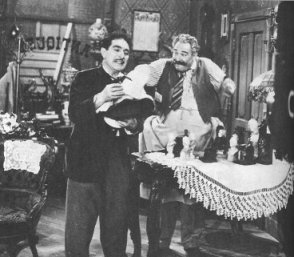
Life with Luigi is an American radio situation comedy series which began September 21, 1948, on CBS Radio and broadcast its final episode on March 3, 1953.
Contents
The action centered on Luigi Basco, an antique shop owner, and his experiences as a newly arrived Italian immigrant in Chicago. Many episodes took place at the night school classes that Luigi attended with other immigrants from different countries. Another common theme involved Luigi's landlord/sponsor, Pasquale, scheming to get Luigi to marry his obese daughter. [1] Perennial character actor and two-time Academy Award nominee J. Carrol Naish played Luigi. [2]
Life with Luigi was created by Cy Howard, who had earlier created the hit radio comedy, My Friend Irma . The working title was The Little Immigrant, echoed in the sign-off of each episode, "Your lovin-a son-a, Luigi Basco, the li'l immigrant." Other characters on the show included Pasquale (Alan Reed), another Italian immigrant who is always trying to trap Luigi into marrying his daughter Rosa (Jody Gilbert); Miss Spaulding (Mary Shipp), Luigi's night school teacher and ideal woman; and Schultz (Hans Conried), a German immigrant and fellow student in Luigi's citizenship class. The other night school classmates were Horowitz (Joe Forte) and the Swedish Olsen (Ken Peters). Native Chicagoan Jimmy (Gil Stratton), Luigi's young helper at the store, featured in the early episodes. Each episode used the framing device of Luigi narrating a letter to his mother back in Italy. [1]
The show was popular, successfully competing with Bob Hope's The Pepsodent Show . For most of its run, Life with Luigi aired at 9 pm on Tuesdays. Despite an estimated 30% share of the audience in its timeslot, the show was without a sponsor [3] until Wrigley's Gum bought it in 1950, continuing till the show ended in 1953. [1]